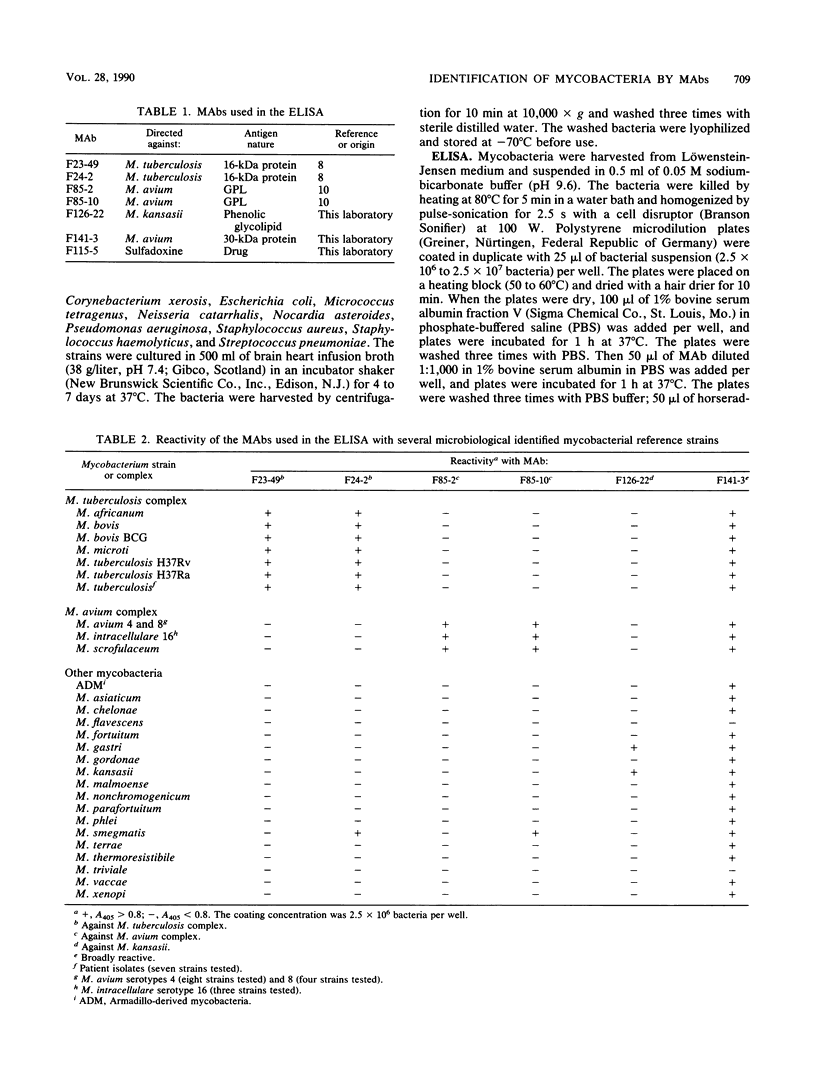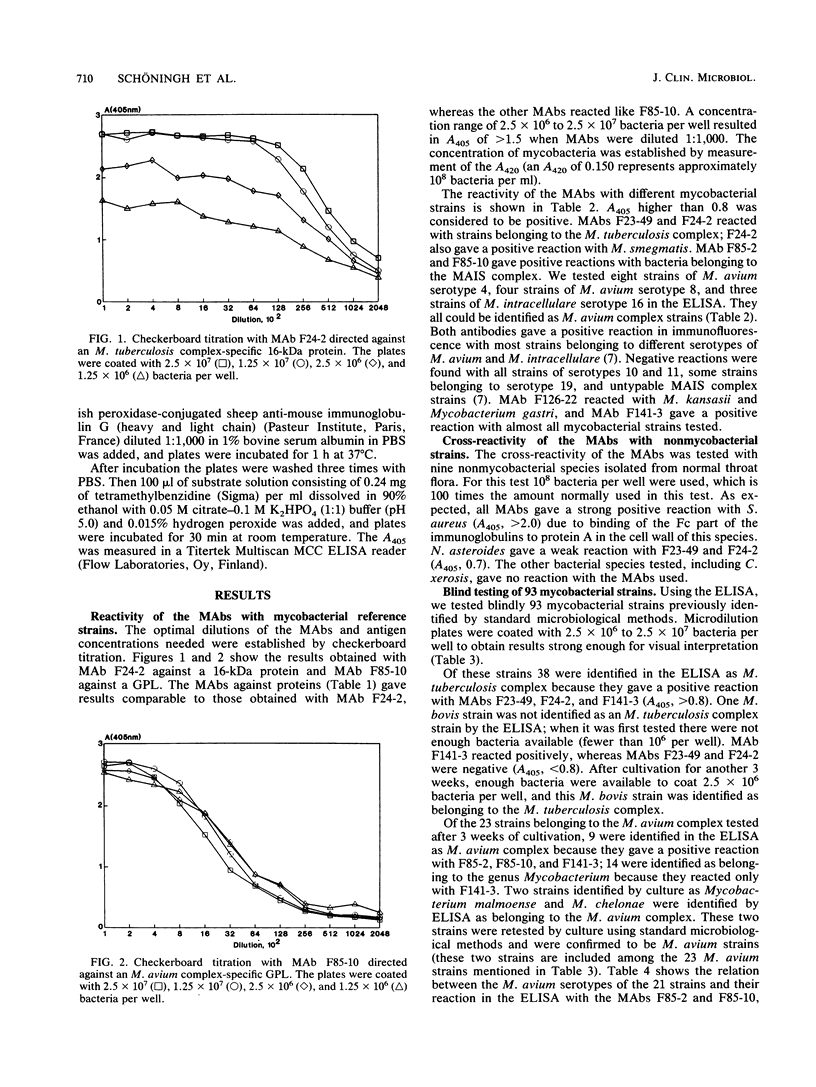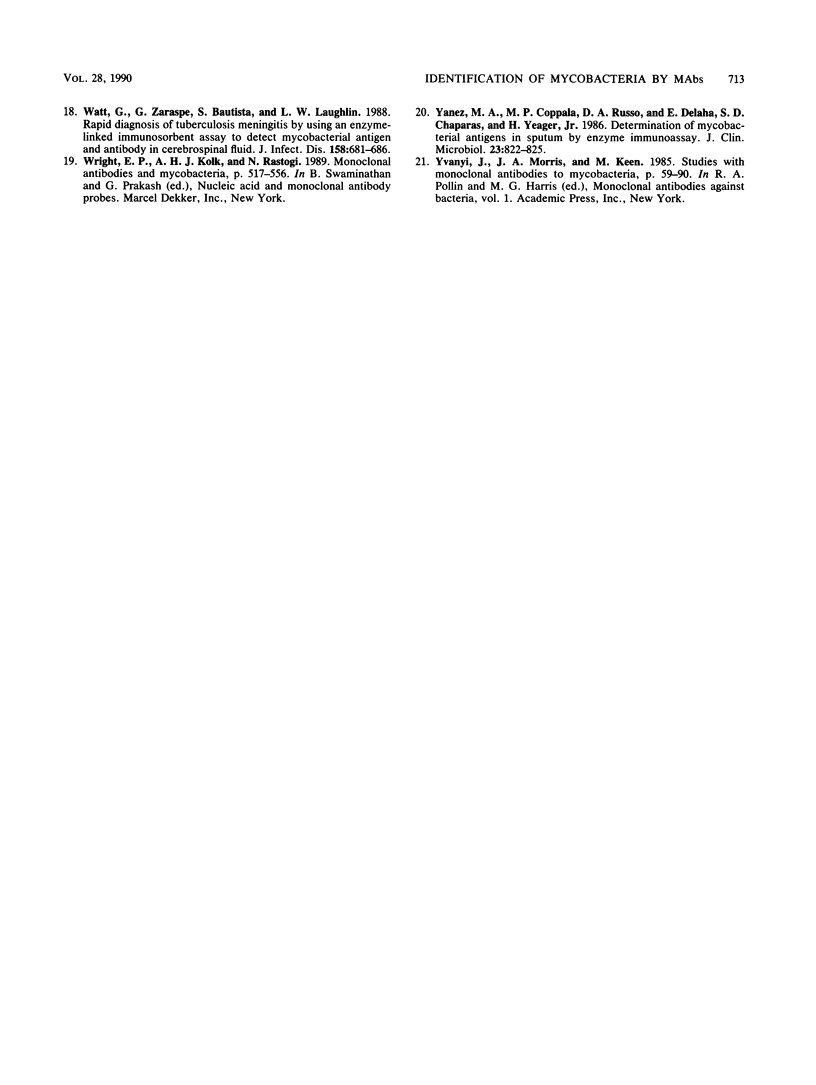Abstract
A simple enzyme-linked immunosorbent assay was developed for the identification of cultured mycobacteria belonging to the Mycobacterium tuberculosis complex, the Mycobacterium avium complex, and Mycobacterium kansasii. Six monoclonal antibodies were used: two (F23-49 and F24-2) were specific for the M. tuberculosis complex, two (F85-2 and F85-10) were specific for the identification of the M. avium complex, one (F126-22) was specific for M. kansasii, and one (F141-3) was broadly reactive and distinguished mycobacteria from other bacteria. In the enzyme-linked immunosorbent assay only 10(6) to 10(7) bacteria derived from early cultures (2 to 3 weeks) were needed for each monoclonal antibody. For the M. tuberculosis complex the sensitivity and specificity were both 100%. For the M. avium complex the specificity was 100% and the sensitivity was 70%. The three M. kansasii strains tested could all be identified as M. kansasii.
Full text
PDF





Selected References
These references are in PubMed. This may not be the complete list of references from this article.
- Brennan P. J. Structures of the typing antigens of atypical mycobacteria: a brief review of present knowledge. Rev Infect Dis. 1981 Sep-Oct;3(5):905–913. doi: 10.1093/clinids/3.5.905. [DOI] [PubMed] [Google Scholar]
- Daniel T. M. Antibody and antigen detection for the immunodiagnosis of tuberculosis: why not? What more is needed? Where do we stand today? J Infect Dis. 1988 Oct;158(4):678–680. doi: 10.1093/infdis/158.4.678. [DOI] [PubMed] [Google Scholar]
- Gonzalez R., Hanna B. A. Evaluation of Gen-Probe DNA hybridization systems for the identification of Mycobacterium tuberculosis and Mycobacterium avium-intracellulare. Diagn Microbiol Infect Dis. 1987 Oct;8(2):69–77. doi: 10.1016/0732-8893(87)90152-0. [DOI] [PubMed] [Google Scholar]
- Kirihara J. M., Hillier S. L., Coyle M. B. Improved detection times for Mycobacterium avium complex and Mycobacterium tuberculosis with the BACTEC radiometric system. J Clin Microbiol. 1985 Nov;22(5):841–845. doi: 10.1128/jcm.22.5.841-845.1985. [DOI] [PMC free article] [PubMed] [Google Scholar]
- Kolk A. H., Evers R., Groothuis D. G., Gilis H., Kuijper S. Production and characterization of monoclonal antibodies against specific serotypes of Mycobacterium avium and the Mycobacterium avium-Mycobacterium intracellulare-Mycobacterium scrofulaceum complex. Infect Immun. 1989 Aug;57(8):2514–2521. doi: 10.1128/iai.57.8.2514-2521.1989. [DOI] [PMC free article] [PubMed] [Google Scholar]
- Kolk A. H., Ho M. L., Klatser P. R., Eggelte T. A., Kuijper S., de Jonge S., van Leeuwen J. Production and characterization of monoclonal antibodies to Mycobacterium tuberculosis, M. bovis (BCG) and M. leprae. Clin Exp Immunol. 1984 Dec;58(3):511–521. [PMC free article] [PubMed] [Google Scholar]
- Kolk A. H., Ho M. L., Klatser P. R., Eggelte T. A., Portaels F. Production of monoclonal antibodies against Mycobacterium leprae and armadillo-derived mycobacteria. Ann Inst Pasteur Microbiol. 1985 Sep-Oct;136B(2):217–224. doi: 10.1016/s0769-2609(85)80046-6. [DOI] [PubMed] [Google Scholar]
- McNeil M., Tsang A. Y., Brennan P. J. Structure and antigenicity of the specific oligosaccharide hapten from the glycopeptidolipid antigen of Mycobacterium avium serotype 4, the dominant Mycobacterium isolated from patients with acquired immune deficiency syndrome. J Biol Chem. 1987 Feb 25;262(6):2630–2635. [PubMed] [Google Scholar]
- Middlebrook G., Reggiardo Z., Tigertt W. D. Automatable radiometric detection of growth of Mycobacterium tuberculosis in selective media. Am Rev Respir Dis. 1977 Jun;115(6):1066–1069. doi: 10.1164/arrd.1977.115.6.1066. [DOI] [PubMed] [Google Scholar]
- Papa F., Riviere M., Fournié J. J., Puzo G., David H. Specificity of a Mycobacterium kansasii phenolic glycolipid (mycoside A) immunoserum. J Clin Microbiol. 1987 Dec;25(12):2270–2273. doi: 10.1128/jcm.25.12.2270-2273.1987. [DOI] [PMC free article] [PubMed] [Google Scholar]
- Results of a World Health Organization-sponsored workshop to characterize antigens recognized by mycobacterium-specific monoclonal antibodies. Infect Immun. 1986 Feb;51(2):718–720. doi: 10.1128/iai.51.2.718-720.1986. [DOI] [PMC free article] [PubMed] [Google Scholar]
- Schaefer W. B. Serologic identification and classification of the atypical mycobacteria by their agglutination. Am Rev Respir Dis. 1965 Dec;92(6):85–93. doi: 10.1164/arrd.1965.92.6P2.85. [DOI] [PubMed] [Google Scholar]
- Tsukamura M. A review of the methods of identification and differentiation of mycobacteria. Rev Infect Dis. 1981 Sep-Oct;3(5):841–861. doi: 10.1093/clinids/3.5.841. [DOI] [PubMed] [Google Scholar]
- Watt G., Zaraspe G., Bautista S., Laughlin L. W. Rapid diagnosis of tuberculous meningitis by using an enzyme-linked immunosorbent assay to detect mycobacterial antigen and antibody in cerebrospinal fluid. J Infect Dis. 1988 Oct;158(4):681–686. doi: 10.1093/infdis/158.4.681. [DOI] [PubMed] [Google Scholar]
- Yáez M. A., Coppola M. P., Russo D. A., Delaha E., Chaparas S. D., Yeager H., Jr Determination of mycobacterial antigens in sputum by enzyme immunoassay. J Clin Microbiol. 1986 May;23(5):822–825. doi: 10.1128/jcm.23.5.822-825.1986. [DOI] [PMC free article] [PubMed] [Google Scholar]


